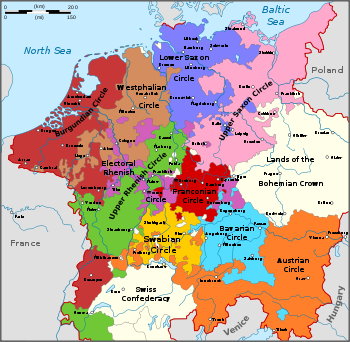- Imperial Circle
-
An Imperial Circle (Latin: Circulus imperii, plural Circuli imperii German: Reichskreis, plural Reichskreise) comprised a regional grouping of territories of the Holy Roman Empire, primarily for the purpose of organizing a common defensive structure and of collecting the imperial taxes, but also as a means of organization within the Imperial Diet and the Imperial Chamber Court.
Each circle had a Circle Diet, although not every member of the Circle Diet would hold membership of the Imperial Diet as well.
Contents
Formation of the Imperial Circles
Initially the 1500 Diet of Augsburg set up six circles as part of the Imperial Reform:
- the Bavarian Circle
- the Swabian Circle
- the Upper Rhenish Circle
- the Lower Rhenish-Westphalian Circle
- the Franconian Circle
- the Saxon Circle
Originally, the territories held by the Habsburg dynasty and the Electors remained unencircled. In 1512 the Diet at Trier and Cologne organized these lands into four more circles:
- the Austrian Circle, including the Habsburg territories inherited by Maximilian I
- the Burgundian Circle, including the patrimony of Maximilian's late wife, Mary of Burgundy
- the Upper Saxon Circle, including the Electorates of Saxony and Brandenburg
- the Electoral Rhenish Circle, including the ecclesiastical Electorates of Mainz, Cologne and Trier, and the secular Electoral Palatinate.
In view of French claims raised to Maximilian's Burgundian heritage, the 1512 Diet initiated the official use of the name Holy Roman Empire of (the) German Nation (Latin: Sacrum Imperium Romanum Nationis Germanicæ) in its Final Act.[1][2]
Though the Empire lost several western territories after the secession of the Seven United Netherlands in 1581 and during the French annexations of the 1679 Peace of Nijmegen, the ten circles remained largely unchanged until the early 1790s, when the French Revolutionary Wars brought about significant changes to the political map of Europe.
Territories of the Holy Roman Empire outside the Imperial Circles
A number of imperial territories remained unencircled, for instance:
- the Lands of the Bohemian Crown (i.e. the Kingdom of Bohemia with the March of Moravia, the Duchies of Silesia, as well as Upper and Lower Lusatia)
- the territories of the Swiss Confederacy
- Imperial territories in northern Italy: Mantua, Milan, Modena, Montferrat, Parma and Tuscany
- territories of Imperial Knights
- minor territories, such as:
- the County of Montbéliard
- the Lordship of Schmalkalden
- the Lordship of Jever
- the peasant republic of Dithmarschen (until incorporated into Holstein in 1559)
Notes
- ^ Peter Hamish Wilson, The Holy Roman Empire, 1495-1806, MacMillan Press 1999, London, page 2
- ^ The Holy Roman Empire of the German Nation at the Embassy of the Federal Republic of Germany in London website
References
- Imperial Circles in the 16th Century Historical Maps of Germany
Circles of the Holy Roman Empire after the Imperial Reform Created in 1500 Bavarian · Franconian · Westphalian (Lower Rhenish-Westphalian) · Lower Saxon · Swabian · Upper Rhenish
Created in 1512 and Territories of the Holy Roman Empire outside the Imperial CirclesCategories:- Circles of the Holy Roman Empire
- Types of country subdivisions
- States and territories established in 1500
Wikimedia Foundation. 2010.

